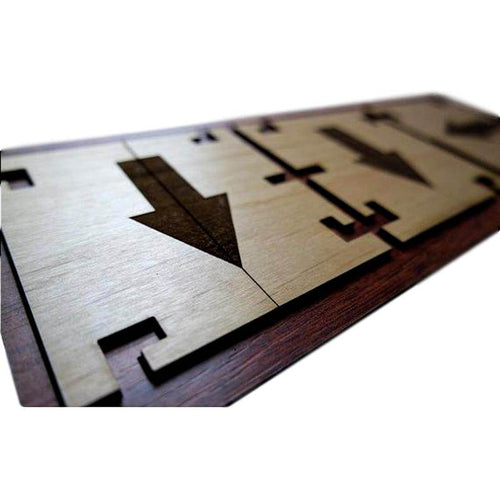It is important to understand each of the puzzles and props in your Escape Room to ensure you can utilize their full potential. With this in mind I have created an instructional series to help familiarize yourself with our Cipher Wheels and Encryption Machines.
For articles on how to use our other Cipher Wheels please see the links below:
For this installment we have the Alberti Cipher Disc:
The Alberti Cipher Disk was invented over five centuries ago by the famous Italian scholar Leon Battista Alberti in 1467. Alberti was an amazingly brilliant Renaissance genius whose talents covered a wide range of fields. He was a renowned architect, a dedicated linguist, a Latin language expert, a poet, a priest, a philosopher, an educated lawyer, an astounding mathematician, an engineer, author, astronomer, a master horseman, and a cryptographer! The Alberti Cipher Disk is the first example of a true “polyalphabetic” cipher device using two dissimilar alphabets. It can be postulated, from Alberti's writings, that this cipher device may have been created for high level secret use within the Vatican.
The Primary Encoding Method:
Now, to begin - you and your receiver must agree on the letter to be used as the initial pointer, and a starting key letter to place above it. This gives 576 possible starting combinations, but in actuality - only 24 possible Inner disk positions. So, for better security (we suggest), perhaps a starting keyword. Let us again use Alberti's small k as the pointer. If my keyword is “velvet”, I would first place the k, first under the capital V, and then find the first letter I wish to encode on the outer disk, and then write down the Inner disk letter below it. I will then rotate the k under the E, and continue with the second letter of my message. This method is the same as used with a Vigenere cipher - but wait… this it is only to hide what comes next… (as the keyword does NOT repeat).
At the conclusion the of keyword rotations, we select one of the numbers: 1, 2, 3, or 4, from the Outer disk and write down the corresponding small case letter (or Ampersand) from the Inner disk. This tells the decoder to rotate the Inner disk of the device one to four letters to the right (or possibly to the left). These rotation commands can then be further placed at random throughout the message body and are completely masked by the resulting jumble of letters which make up the encoded message. Since the keyword does not repeat, and further rotations are controlled by embedded numbers, it becomes much harder to find any patterns within the resulting cryptogram. ( Note: When using the device with the English language, and employing the suggested digraphs for missing letters - sometimes placing disk rotation digits between the digragh's letters will further aid to the complexity and security of the resulting encryption. For example: H, being replaced with the digraph: FF, might be pre-encoded as F2F. This will results in the digraph being encoded to two different letters and thereby hiding repeated double letter usage within the encryption.)
However, the fun has just begun, because while the four numbers - when used as single digits are to denote inner disk movements… when used in groups of two, three, or four digits together can be used for “superencipherment” or as unique numeric codes that correspond to definitions within a code book., Furthermore, the numbers 1, 2, 3, & 4 need not have to always represent their actual face value; and can indeed change in value, as defined per code book instructions.
Alberti suggested that using groups of two, three, or four numbers together; allows for 336 different words, groups of words, numbers, disk rotation functions, letter switches, etc. This creates a very flexible and customizable system. For example, 22 might mean: “move the Inner disk pointer 12 letters to the left“! 14 could mean, make letter “t” the new pointer. 333 could be the code for: “The Pope”. You might wish to use a bank of these numbers to represent frequently used words (“attack” might be 2112, “assassinate” might be 2122, “immediately“ might be: 213, and so forth. This can help to greatly compress the size of your messages, and increase its secrecy. Even if the message is intercepted and somehow decoded, without the corresponding code book, it is quite possibly worthless.
You may also use some of these numbers for the most sensitive and secret aspects of what you are trying to communicate (about whom, or where). 1111 could mean: “the next ten letters you decode are backwards, reverse them”! Indeed, one might even thwart and confound any fragmental frequency letter analysis attempts on the fly, by simply adding a code such as this: 4242 - “All my letters that decode to “D” that follow, should be written as “E”. Since all these changes can happen randomly at the encoders fancy, it can be a true nightmare for code breakers! The possibilities for additional complexities in the code, as detailed via a code book and conveyed by a single number (2 to 4 digit number) are endless! Of course, the matching code books now need to be conveyed between sender and receiver very carefully, and kept safe (alas, the downfall of many a secret cipher systems)!
Here is the first two digit number set. There are 16 values:
11 12 13 14 21 22 23 24
31 32 33 34 41 42 43 44
In the three digit number set there are 64, and 256 values in the 4 digit number set
.It is quite possible the amazing value and flexibility of having numbers on a cipher disk was not properly understood or appreciated by many following cryptographic device inventors - as the inclusion of numbers on cipher devices did not appear again for several centuries.
Encoding of Numbers:
Numbers can be handled in a variety of ways, however we suggest the following:
1. Roman Numerals. These work just fine with the Alberti Cipher and are quite easy to work with.
2. Use the “Base 5” number system. Since the Alberti Cipher Disk includes the numbers 1 through 4, one only needs to employ the capital letter O as Zero, and we have a full base five number system. Remember in base five, value of the columns right to left are
1s, 5s, 25s, 125s, 625s, 3125s…
You can find the base 5 equivalent of any base 10 number by long division through a simple mathematical method. Converting from base 5 to base 10 is an easy matter of multiplying the value of the columns and adding the results. By using the Base 5 system, you can further add to the complexity, and therefore resulting security of the generated cryptogram.
Final Processing:
Once your cipher is complete you will have a string of lower case letters and possibly the Ampersand symbol. As mentioned earlier, the use of graph paper can be very helpful in encoding and decoding ciphers. A dry-erase whiteboard is also handy for security. To hide the fact that you are using an Alberti Cipher, we suggest that you do the following three steps (if employing the 2nd method):
1. Rewrite the cipher text in all UPPER CASE letters.
2. Arrange the letters in groups of four letters, of six groups per line as below:
FRXZ QVVI TZXC CBNA DESH &XZI
3. Finally, replace the all telling “&” signs, randomly with either: J, U, or W. Make sure you communicate with your receiver that any time these letters are found in a cipher text message: they all mean the Ampersand sign. The Ampersand is unique to the Alberti Cipher, so it's a telltale signal to a code breaker, you are using one… Don't do it!
For example: with the above, the “&” is randomly replaced with “J“:
FRXZ QVVI TZXC CBNA DESH JXZI
The resulting cryptogram gives no hints as to what method was used to do the encoding process. This is very important in keeping your message secure. Additionally, the random replacement of the Ampersand with one of the three letters will further add to the complexity of the resulting cryptogram.


0 comments